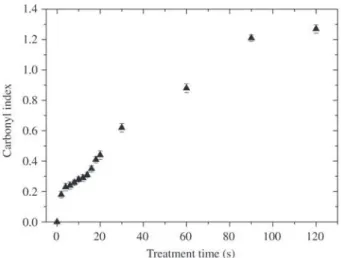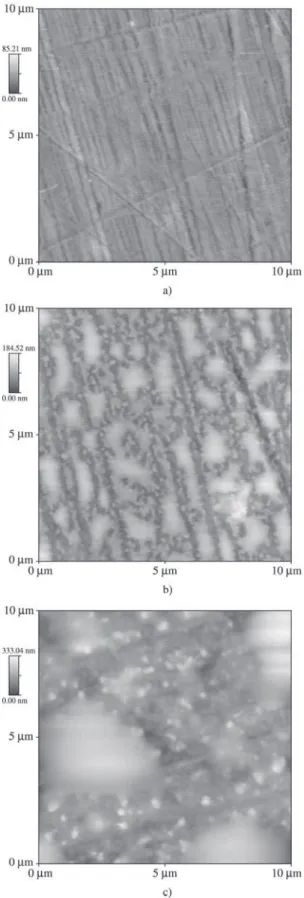Vol. 6, No. 2, 2003 Surface Composition Analysis of PP Films Treated by Corona Discharge 163
Materials Research, Vol. 6, No. 2, 163-166, 2003. © 2003
*e-mail: nsellin@yahoo.com.br
Trabalho apresentado no I Simpósio Mineiro de Ciências dos Materiais, Ouro Preto, Novembro de 2001.
Surface Composition Analysis of PP Films Treated by Corona Discharge
Noeli Sellin*, João Sinézio de C. Campos
Departamento de Tecnologia de Polímeros, Faculdade de Engenharia Química, Universidade Estadual de Campinas, C.P. 6066, 13083-970 Campinas - SP, Brazil
Received: November, 11 2001; Revised: March 3, 2003
Polypropylene films (PP) surface treated by corona discharge in air was analyzed to verify the changes on surface composition. The presence of oxidized polar groups on the film surface, mainly, C=O, C-O and COH, was confirmed by infrared spectroscopy (FTIR/ATR) and atomic force microscopy (AFM) revealed a dramatic change in the morphology and provided qualitative re-sults of the chemical composition (new structures). Contact angle (q) of the PP films decreased after corona treatment indicating an increase in the wettability due to the polar groups formed. Extended treatment results of low molecular weight oxidized material into the surfaces and a smaller additional degree of modification in the wettability is obtained.
Keywords: polypropylene, corona treatment, surface composition, wettability
1. Introduction
Many industrial applications of polypropylene films re-quire good adhesion properties, for example, adhesion by printing ink, paints and coatings, lamination and conven-tional adhesives. Generally, the presence of polar groups and the morphology of the film surface play a very impor-tant role for obtaining good adhesion1-3. However,
polypropylene films have limitations to their adhesion prop-erties due to their non-polar nature and low surface tension. One of the techniques used to modify surface is the expo-sure of the polymer to corona discharge4,5. The corona
dis-charge is an electrical disdis-charge between two electrodes obtained under atmospheric pressure from a high voltage ac current. The electrical field generated, excites the gas molecules (air) and dissociates some of them. These charged active species may react with polymer molecules that, also, are activated accordingly and may occur breaking of mo-lecular bonds on the surface and addition of polar oxygen atoms (mainly, COH, C=O and C-O). It is commonly as-sumed in the literature that surface oxidation during corona treatment is via a free radical process and the following re-actions are proposed to account the PP surface oxidation (scheme 1)6.
This mechanism only involves oxygen as a reactive spe-cies but other possibilities exist for the introduction of oxy-gen functionalities into the surface through reaction with water, nitrogen oxides and derived from them, but these
groups are present at very low levels. Although the modifi-cation of polymer surfaces by corona discharge has already been studied, further research work is necessary in order to understand changes in the surface composition, wettability and morphology that are important in controlling the modi-fication and to obtain good adhesion properties. In this work was investigated the surface modification of PP films treated by corona discharge through FTIR/ATR spectroscopy (chemical structure), contact angle goniometry (wettability) and atomic force microscopy (morphology). These tech-niques have already been used to investigate polymer sur-faces involving other applications7-9.
164 Sellin & Campos Materials Research
2. Experimental
2.1 Surface Treatment
Isotatic PP films (28 µm of thickness, blow extrusion -Policast) were previously washed with acetone (99.8%, Merck) and dried to eliminate surface contaminants. After cleaning, the samples were treated by corona discharge in air (point-to-plate system), with applied voltage ~5000 V, distance between electrodes of 3 mm, in different times and controlled environment condition (temperature ~20 °C and relative humidity ~55%).
2.2 Surface Characterization
• To analyze the changes of chemical structure induced by corona treatment, FTIR analysis was carried out in a Perkin Elmer SPECTRUM-2000 spectrometer, in the attenuated total reflectance (ATR) mode, equipped with a ZnSe crystal prism (incidence angle of 45°). All analyses were performed with a resolution of 4 cm-1 and 10 scans for samples. The carbonyl index
was determined by the ratio between the maximum absorbance bands at 1720 cm-1 (assigned to C=O) and
at 1170 cm-1, taken as a reference.
• The wettability of the PP films was determined by the detection of the contact angle formed at the interface of water drop and the PP film surface using a goni-ometer (Tantey, CAM-MICRO). The deionized-disttiled water was put on the surface in the shape of a sessile drop using a clean syringe and was allowed to equilibrate for about 30 s. Then, by a monitor magni-fied on the interface of film surface and the water drop, the final contact angle was taken from the average value of continuous measurement of ten times. • PP surface morphology was investigated using an
atomic force microscope (Thermo Microscope autoprobe CP). The samples were scanned with a stand-ard silicon nitride cantilever supplied by the microscope manufacturer and all atomic force microscopy (AFM) measurements were performed in ambient atmosphere and contact mode. The applied force was always mini-mized, not to deform the samples.
3. Results and Discussion
3.1 Chemical Composition (FTIR/ATR)
FTIR/ATR spectra of the untreated and corona treated PP films are shown in Fig. 1. The comparison between these spectra reveals the generation of new polar groups in the films due to corona treatment in air. The appearance of an absorption band in the 3600-3200 cm-1 regions is assigned
to hydrogen bond of alcohol (-OH); the peak at 1720 cm-1
confirm the presence of carbonyl (C=O) of the -COOH
group, and at 1645 cm-1 corresponds to a C=O group
adja-cent to an olefinic double bond or enolic C=O group present in the treated PP film. The assigned carbonyl absorption peak intensities increase with the treatment time, as showed by the carbonyl index in the Fig. 2. An absorption band at 1300-1100 cm-1 is observed and corresponds to ester group
(C-O)10. Oxidized nitrogen groups are not detected in all of
cases.
3.2 Morphology (AFM)
The surface modification as well as the changes in mor-phology were measured by AFM analysis. The Fig. 3 shows the AFM topographic images for (a) untreated, (b) 2 s and (c) 30 s corona treated PP films. The untreated film surface
Figure 1. FTIR/ATR spectra for (a) untreated; (b) 2 s; (c) 10 s; (d) 30 s corona treated PP films.
Vol. 6, No. 2, 2003 Surface Composition Analysis of PP Films Treated by Corona Discharge 165
is characterized by rough surface with granular structures and presents some orientation, which results from manufaturacting process (blow extrusion). After corona treatment, PP film surface shows remarkable changes in the morphology as small droplets. Atomic oxygen formed in corona discharge, in air, reacts with PP chains and forms oxidized polar groups on the surface. Increasing surface oxidation, i.e. increasing the corona treatment time, the polymer chain scission continues, decreasing the molecu-lar weight of the materials formed on the surface and in-creasing the liquidity of these materials which results in large droplets.
3.3 Wettability (Contact Angle)
Figure 4 illustrates the contact angle (θ) as a function of corona treatment time. Untreated PP film shows contact angle (using water) of 90° and corona discharge produced substantial changes in the contact angle. It is apparent that 2 s treatment time is sufficient to decrease the contact angle of 90° up to 54° and that by further treatment a smaller additional degree of modification is obtained, i.e. after 10 s treatment time a saturation of the contact angle occurs (θ ~50°). Extended treatment for several seconds appears unnecessary and instead is likely to cause some ablation and ultimately surface roughening11. For industrial
applica-tions short corona treatment times are required for com-mercial viability. Corona discharge treatment introduces polar groups containing oxygen into the surfaces of PP films resulting in increased wettability that is necessary to obtain good adhesion properties. Adhesion force measurements (using AFM analysis) of the corona treated PP films were showed in previous work12 and it was possible to verify the
increasing in the adhesion force after corona treatment. Figure 3. AFM topographic images for (a) untreated; (b) 2 s;
(c) 30 s corona treated PP films.
166 Sellin & Campos Materials Research
4. Conclusions
Corona discharge treatment of PP films leads to the in-corporation of various chemical groups containing oxygen, mainly C=O, into the films. As a result, the surface wettability by water (polar liquid) increases (contact angle decreases), which is the reason for the improvement of adhesion per-formance of polymer. Increasing the treatment time showed an increase of the oxygen groups and the formation of drop-lets on the surface, which are results of low molecular weight oxidized material formed during the oxidation process.
Acknowledgements
The authors thank Policast for supplying the films, Dr. Mauricio U. Kleinke and Marta E. R. Dotto (Laboratório de Interfaces/IFGW/UNICAMP) for assistance with AFM analysis and CNPq for financial support.
References
1. Owens. D.K.; Wendt, R.C. Journal of Applied Polymer Science, v. 13, p. 1741, 1969.
2. Briggs, D.; Kendall, C.R. Polymer, v. 20, p. 1053, 1979.
3. Xiao, G.Z. Journal of Materials Science Letters, v. 14, p. 761-762, 1995.
4. Fourche, G. Polymer Engineering and Science, v. 35, n. 12, p. 968-974, 1995.
5. Mangipudi, V.; Tirrel, M. Langmuir, v. 11, p. 19-23, 1995. 6. Briggs, D.; Kendall, C.R.; Blythe, A.R.; Wootton, A.B.
Polymer, v. 24, p. 47, 1983.
7. Klöpffer, W. Introduction to Polymer Spectroscopy, Spring-Verlag, v. 7, 1983.
8. Comyn, J. Adhesion Science, RSC Paperbacks, Cam-bridge, 1997.
9. Herrmann, P.S.P.; Silva, M.A.P.; Bernardes, F.R.; Job, A.E.; Colnago, L.A.; Frommer, J.E.; Mattoso, L.H.C. Polímeros: Ciência e Tecnologia, out/dez, p. 51-61, 1997. 10. Colthup, N.B.; et al. Introduction to Infrared and
Ra-man Spectroscopy, Academic Press, 2. Ed., 1964. 11. Nie, H.Y.; Wlazak, M.J.; Berno, B.; McIntire, N.S.
Ap-plied Surface Science,v. 144-145, p. 627-632, 1999. 12. Sellin, N.; Campos, J.S.C.; Kleinke, M.U. Acta

